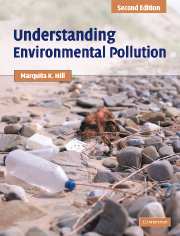Book contents
- Frontmatter
- Contents
- Preface
- Acknowledgements
- List of abbreviations and acronyms
- Chapter 1 Understanding pollution
- Chapter 2 Reducing pollution
- Chapter 3 Chemical toxicity
- Chapter 4 Chemical exposures and risk assessment
- Chapter 5 Air pollution
- Chapter 6 Acidic deposition
- Chapter 7 Global climate change
- Chapter 8 Stratospheric-ozone depletion
- Chapter 9 Water pollution
- Chapter 10 Drinking-water pollution
- Chapter 11 Solid waste
- Chapter 12 Hazardous waste
- Chapter 13 Energy
- Chapter 14 Persistent, bioaccumulative, and toxic
- Chapter 15 Metals
- Chapter 16 Pesticides
- Chapter 17 Pollution at home
- Chapter 18 Zero waste, zero emissions
- Index
- References
Chapter 3 - Chemical toxicity
- Frontmatter
- Contents
- Preface
- Acknowledgements
- List of abbreviations and acronyms
- Chapter 1 Understanding pollution
- Chapter 2 Reducing pollution
- Chapter 3 Chemical toxicity
- Chapter 4 Chemical exposures and risk assessment
- Chapter 5 Air pollution
- Chapter 6 Acidic deposition
- Chapter 7 Global climate change
- Chapter 8 Stratospheric-ozone depletion
- Chapter 9 Water pollution
- Chapter 10 Drinking-water pollution
- Chapter 11 Solid waste
- Chapter 12 Hazardous waste
- Chapter 13 Energy
- Chapter 14 Persistent, bioaccumulative, and toxic
- Chapter 15 Metals
- Chapter 16 Pesticides
- Chapter 17 Pollution at home
- Chapter 18 Zero waste, zero emissions
- Index
- References
Summary
A major reason that we care about a pollutant is that it may be toxic – to ourselves, to wildlife, and to plants, including our crops. This chapter examines the toxicity of chemicals and factors affecting toxicity. Section I introduces “the dose makes the poison,” and acute and chronic toxicity. It follows a chemical as it contacts the body, is absorbed into and distributed around it, its transformation within the body, and its excretion. Some chemicals are stored and bodily concentrations build up. Section II discusses factors that affect toxicity, including gender, age, nutrition, and variation in sensitivity to toxic substances both within one species and between species. Section III emphasizes adverse effects that especially concern us. One is those that harm the very young, developing embryos and small children, why they are especially sensitive to toxic effects and often have greater exposures than adults. Section IV examines two types of chemicals that concern many people, agents that can cause cancer and those that can mimic natural hormones.
SECTION I
All substances are toxic
Paracelsus, a controversial sixteenth-century physician, was faulted for treating his patients with arsenic and mercury that were known to be toxic. Paracelsus responded with a statement still repeated 500 years later: “All substances are poisons. There is none, which is not a poison. The right dose differentiates a poison and a remedy.” That is, a “non-toxic” substance can be toxic at a high-enough dose.
- Type
- Chapter
- Information
- Understanding Environmental PollutionA Primer, pp. 51 - 80Publisher: Cambridge University PressPrint publication year: 2004

